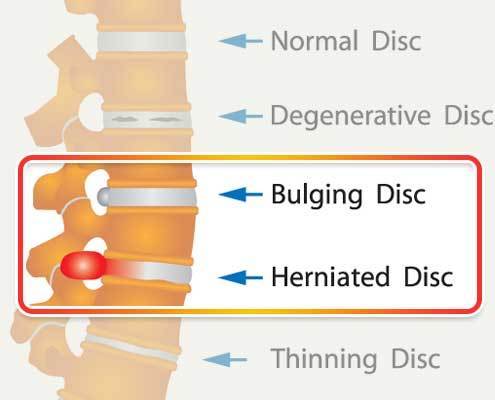
If a disc bulges or herniates, the experience for the patient can differ significantly. These conditions can present differently, have different progressions, and will be treated differently. A common question is, if they’re both disc problems, why would they be so different? In this article, we briefly discuss what makes these conditions so different!
The way your body interacts with the damaged disc is what dictates your experience. The discs in the spine are made of two layers, much like a jelly donut. The outer layer (annulus fibrosis) of the disc is made of similar material as your ligaments, and the inner layer (nucleus pulposus) of the disc is made of a soft jelly center.
In a disc bulge, the outer layer is damaged, but not enough for the jelly to come out. The outer layer is just like any other ligament in the body, it has a poor blood supply. This means inflammation at the site of the disc bulge is limited and anti-inflammatory drugs typically won’t do much for the pain. The body will respond to damage by swelling up and tightening muscles in the area. This prevents movement which will prevent further damage from occurring.
In a disc herniation, the outer layer is damaged enough for a hole to appear, allowing the jelly to exit the disc. That jelly has been inside your disc since your embryotic stages of existence. The body’s immune system developed after the discs formed and therefore your body thinks that jelly is a foreign entity. Much like an infection, an immune response takes place at the site of the herniation to remove the foreign entity. This helps eat away the herniated piece and speeds up the healing process.
Medical treatment for these conditions can vary. While a herniation may respond to anti-inflammatory drugs, a bulge may not. Muscle relaxers may help ease the tension, but don’t touch the pain. Chiropractic treatment for both conditions has proven to help relax the affected muscles and restore movement to the joints in the spine. The improved range of motion from the relaxed muscles and unrestricted joints will help increase blood flow to the damaged disc and speed up healing. Mechanical traction may also be used to treat these disc injuries. This method creates a negative pressure inside the disc, attempting to pull the bulge or herniation back in.
Due to the immune response from the body, a herniated disc may start to feel better in a couple weeks with early treatment. A bulging disc, depending of the severity and time before seeking treatment, can become a more chronic problem. This can result in significantly longer recovery times. If you think you may have a disc injury, call to schedule an appointment at your local Rochester chiropractor! Here at Rush-Henrietta Family Chiropractic, we have all the tools to treat both disc bulges and herniations.
Image source: https://louisianapain.com/bulging-disk-vs-herniated-disk/



